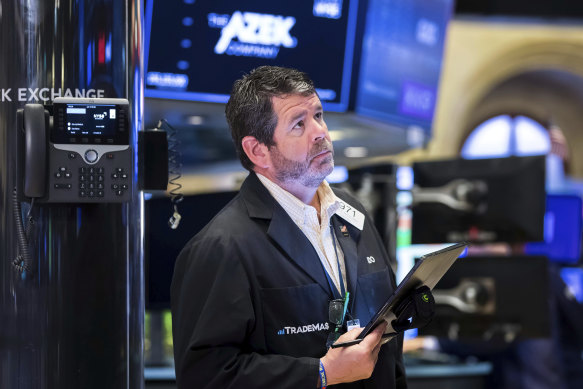ASX set to slip as Wall Street retreats on inflation report
By Stan Choe
Wall Street is lower after a report suggested inflation may not be slowing as quickly and as smoothly as hoped.
The S&P 500 was 0.5 per cent lower in early-afternoon trading, while yields shot higher in the bond market as investors braced for the Federal Reserve get firmer on interest rates to combat inflation. The Dow Jones was down 0.4 per cent while the Nasdaq composite was 0.1 per cent higher. The Australian sharemarket is set to open lower, with futures at 5am AEDT pointing to a fall of 16 points, or 0.2 per cent, at the open. The ASX added 0.2 per cent on Tuesday.

The report was so hotly anticipated because inflation and the Federal Reserve’s response to it have been at the centre of Wall Street’s struggles for more than a year. Inflation has been cooling since a summertime peak, and investors are trying to guess how quickly and smoothly a decline could happen to the Fed’s 2 per cent target.
Tuesday’s report showed that inflation slowed to 6.4 per cent in January from its peak of 9.1 per cent in June. The hope on Wall Street has been for a continuing slowdown to get the Federal Reserve to pause its hikes to interest rates and perhaps begin contemplating cuts to them.
High rates can drive down inflation but also raise the risk of a severe recession and hurt investment prices. The Fed has already hiked its key short-term rate to a range of 4.50 per cent to 4.75 per cent, up from virtually zero a year ago.
Nearly half of January’s month-over-month inflation also came from an area where Fed chair Jerome Powell has said he sees easing pressure in the pipeline: housing and other shelter-related prices.
But on the downside for markets, the improvement in inflation wasn’t by as much as economists expected. That could encourage the Fed to be more aggressive on interest rates than it’s been saying. The Fed has indicated it envisions at least a couple more increases before holding rates at a high level for a while.
“While inflation is heading in the right direction, there is a long and bumpy road ahead to price stability,” said Andrew Patterson, senior economist at Vanguard.
Even after ignoring the effects of prices for food and energy, which can swing more sharply than others, what’s called “core inflation” was still slightly higher than expected last month.
Such strength “suggests that the Fed has a lot more work to do to bring inflation back to 2 per cent,” said Maria Vassalou, co-chief investment officer of multi-asset solutions at Goldman Sachs Asset Management. “If retail sales also show strength tomorrow, the Fed may have to increase their funds rate target to 5.5 per cent in order to tame inflation.”
Investors have been raising their forecasts for how high the Fed will take rates by the summer, and they’re now betting on a nearly 22 per cent probability that its key rate will top 5.5 per cent by July. That’s up from just a 0.2 per cent probability seen a month ago, according to CME Group.
In the end, several analysts said Tuesday’s inflation report confirms a cooling trend but doesn’t answer any big questions by itself.
“This inflation print served as a reminder to investors that the path to lower inflation is not as clear-cut as previously thought and it is too early for the Fed to declare victory on inflation,” said Gargi Chaudhuri, head of iShares Investment Strategy, Americas.
The market’s expectations for the Fed have been driving yields higher in the bond market in particular. The two-year Treasury has shot to its highest level since November, egged on last week after a stronger-than-expected report on the US jobs market.
The two-year yield jumped to 4.64 per cent from 4.52 per cent late Monday. It initially zigzagged up, down and back again after the release of the inflation report.
The 10-year yield, which helps set rates for mortgages and other loans, rose to 3.78 per cent from 3.70 per cent.
In stock markets abroad, Japan’s Nikkei 225 rose 0.6 per cent. Government data showed the world’s third-largest economy grew at an annual pace of 0.6 per cent in October-December, as restrictions related to the coronavirus pandemic eased, both abroad and in Japan. Tourism recovered, as did local travel, and exports grew, the Cabinet Office reported.
AP
Most Viewed in Business
Source: Thanks smh.com